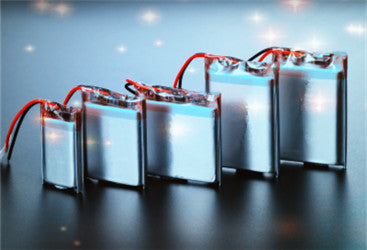
How to understand lipo batteries?
What are the advantages of secondary lithium batteries?
1.High energy density
- High working voltage
- No memory effect
- Long cycle life
- No pollution
- Light weight
- Small self-discharge
What are the advantages of lithium polymer(lipo) batteries?
- Capacity will be doubled compared to the same size lithium-ion battery
- Can be made into a thin battery: with a capacity of 3.6V400mAh, its thickness can be as thin as 0.5mm.
- The battery can be designed into various shapes
- Battery can be deformed
- Can be made into a single high voltage: a battery with liquid electrolyte can only get a high voltage by connecting several batteries in series. Since a polymer battery has no liquid itself, it can be made into multiple layers in a single unit to achieve high voltage.
The IEC specifies the standard cycle life test for lithium batteries as:
After the battery is put at 3.0C / 3.0V
1C constant current and constant voltage charging to 4.2V cut-off current 20mA left for 1 hour and then discharged to 0.2V to 3.0V at 0.2C (one cycle)
The capacity should be more than 60% of the initial capacity after 500 cycles.
After the battery is discharged to 3.0 / support at 0.2C at 25 ° C, it is charged to 4.2V at 1C constant current and constant voltage, the cut-off current is 10mA, and it is stored at 20 + _5 for 28 days, and then discharged at 0.2C to 2.75V. Calculate discharge capacity
What is the internal resistance of lipo battery?
The internal resistance of the battery refers to the resistance experienced by the current flowing through the battery when the battery is working.It is generally divided into AC internal resistance and DC internal resistance.Because the internal resistance of the rechargeable battery is very small, the DC internal resistance is polarized due to the electrode capacity , The internal resistance of polarization is generated, so its true value cannot be measured, and measuring its AC internal resistance can avoid the influence of the internal resistance of polarization and obtain the true internal value.
The AC internal resistance test method is: use the battery equivalent to an active resistance, give the battery a constant current of 1000HZ, 50mA, and a series of processes such as voltage sampling, rectification and filtering to accurately measure its resistance.

What is the internal pressure of a battery?
The internal pressure of the battery is the pressure formed by the gas generated during the charge and discharge process. It is mainly affected by factors such as the manufacturing process and structure of the battery material. Generally, the internal pressure of the battery is maintained at a normal level. The internal pressure of the battery may rise:
If the rate of the compound reaction is slower than the rate of the decomposition reaction, the generated gas can be consumed too late, which will cause the internal pressure of the battery to rise.
What is the internal pressure test?
Lipo battery internal pressure test: (UL standard)
Simulate the battery at an altitude of 15240m (low pressure of 11.6kPa) to check whether the battery is leaking or swollen.
Specific steps: charge the battery 1C with constant current and constant voltage to 4.2V, cut-off current 10mA, and then store it in a low-pressure box with an air pressure of 11.6Kpa and a temperature of (20 + _3) for 6 hours, the battery will not explode. Fire, cracks, leaking fluid.
How does ambient temperature affect battery performance?
Among all the environmental factors, temperature has the greatest impact on the charge and discharge performance of the battery. The electrochemical reaction at the electrode / electrolyte interface is related to the ambient temperature. The electrode / electrolyte interface is considered the heart of the battery. If the temperature decreases, the response rate of the electrode also decreases. Assuming that the battery voltage remains constant and the discharge current decreases, the power output of the battery will also decrease. If the temperature rises, the battery output power rises, and the temperature also affects the transfer speed of the electrolyte. The temperature rises, the transfer temperature decreases, and the transfer slows down. The battery charge and discharge performance is also affected. However, the temperature is too high, exceeding 45, which will destroy the chemical equilibrium in the battery and cause side reactions.

What happens when batteries of different capacities are used together?
If different capacity or new and old batteries are used together, there may be leakage and zero voltage. This is because during the charging process, some batteries are overcharged during charging, some batteries are not fully charged, and high-capacity batteries are not discharged when discharged, while low-capacity batteries are overdischarged. In such a vicious cycle, the battery is damaged and leaks liquid or low (zero) voltage.



Leave a comment